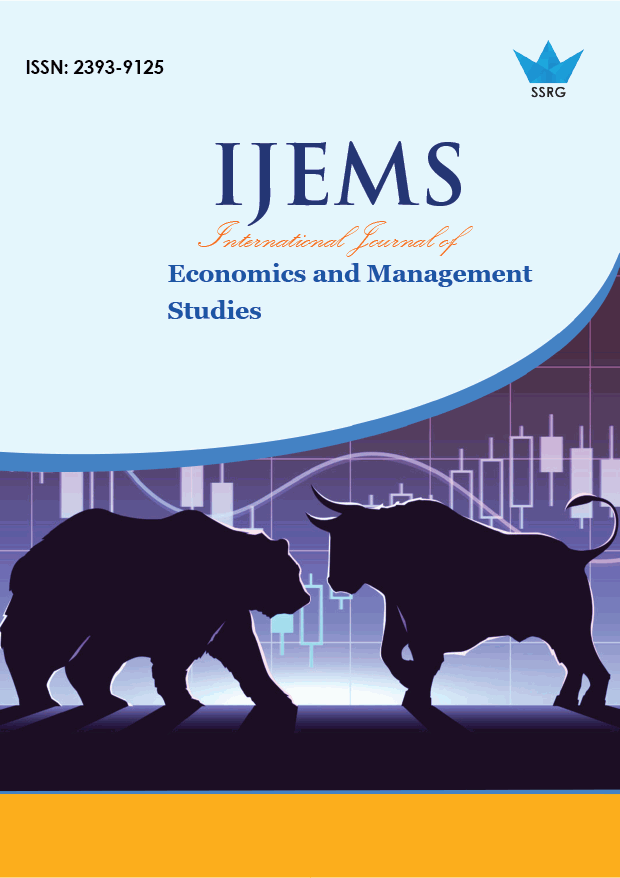Accounting Based Drivers And Implications On Shareholders Value of Quoted Manufacturing Firms In Nigeria

| International Journal of Economics and Management Studies |
| © 2019 by SSRG - IJEMS Journal |
| Volume 6 Issue 12 |
| Year of Publication : 2019 |
| Authors : Ejoh, NdifonOjong (Ph.D.) |
How to Cite?
Ejoh, NdifonOjong (Ph.D.), "Accounting Based Drivers And Implications On Shareholders Value of Quoted Manufacturing Firms In Nigeria," SSRG International Journal of Economics and Management Studies, vol. 6, no. 12, pp. 214-222, 2019. Crossref, https://doi.org/10.14445/23939125/IJEMS-V6I12P124
Abstract:
The paper examined the implications of accounting based drivers on shareholders’ value of quoted manufacturing firms in Nigeria between 2009-2018. Specifically, the paper examined how operating drivers (increase in revenue, increase in operating margins and effective taxation), investing drivers (increase in fixed assets and working capital investments) and financing drivers (Weighted Average Cost of Capital) affect the market price of shares of manufacturing. The expost facto research design was employed and data collected from ten (10) quoted manufacturing firms listed firms in
Nigeria on the Nigerian Stock Exchange (NSE). The results of the test of hypotheses using Ordinary Least Square (OLS) multiple regression analysis indicates that operating drivers and investing drivers are shareholder value increasing, while financing driver is shareholder value decreasing. The paper recommended that manufacturing firms increase their fixed assets and working capital investments in order to increase revenue base and operating margins base, while maintaining an optimal capital structure that reduces their Weighted Average Cost of Capital (WACC), in order to maximize shareholders value.
Keywords:
Shareholders Value, Accounting Revenue, Operating Margins, Fixed Assets Investments, Working Capital Investments, Effective Taxation, Weighted Average Cost of Capital.
References:
[1] Akalu, M. (2001). Re-examining Project Appraisal and Control: Developing a focus on Wealth Creation. International Journal of Project Management, 2001, 19(7), 375-383.
[2] Arzac, E. (1986). Do Your Business Units Create Shareholder Value? Harvard Business Review, 1, 121-126.
[3] Balachandran, B., Nagarajan, N., and Rappaport, A. (1986). Threshold Margins for Creating Economic Value. Financial Management, 15(1), 68-77.
[4] Baltagi, B. (1995). Econometric Analysis of Panel Data. UK: Wiely Publishers.
[5] Barfield, R. (1991). Shareholder Value: Managing for the Long-term. Accountancy, 108, 100101.
[6] Boer, P. (1994). Linking R&D to Growth and Shareholder Value. Research Technology Management, 3, 16-23.
[7] Chakraborty, K., Biswas, B., and Lewis, Cris W. (2000). Economics of Scale in Public Education: An Econometric Analysis. Contemporary Economic Policy, 18 (2), 238-247.
[8] Court, D., and Loch, M. (1999). Capturing the value. Advertising Age, 70(46),46-48.
[9] Dessus, S., and Herra, R. (2000). Public Capital and Growth Revisited: A Pannel Data Assessment. Economic Development and Cultural Change, 48(2), 407-417.
[10] Devlin, G. (1989). A Strategy for Shareholder Value. Accountancy, 1146, 89-90.
[11] Hsiao, C. (1986). Analysis of Panel Data. Econometric Society Monographs, 11, 1-70.
[12] Kelm, K., Karayana, K., and Pinches, G. (1995). Shareholder Value Creation during R&D innovation and Commercialisation Stages. Academy of Management Journal, 38 (3), 770786.
[13] Matyas, L., and Sevestre, P. (1996). The Econometrics of Pannel Data: A Handbook of Theory with Applications, 2nd ed., The Netherlands: KluwerAcademic Publishers.
[14] Mills, R. (1998). The Dynamics of Shareholder Value. Mars Business Associates Ltd., UK.
[15] Mills, R., and Print, C. (1995). Strategic Value Analysis. Management Accounting, 73(2), 3537.
[16] Mills, R., Robertson, J., and Ward, T. (1992). Strategic Value Analysis: Trying to Run Before You Can Walk. Management Accounting, 70(10), 48-49.
[17] Moskowitz, J. (1988). What is Your Business Worth? Management Accounting, 66(9), 30-34.
[18] Myhran, B. (1993). Aligning Owner-Management Goals with Stock based Compensation. Bankers Magazine, 176(5), 72-76.
[19] OECD (2000). Labour Force Statistics 1979-1999. Paris, France, PP.2-35.
[20] Philip, S. (1998). Shareholder Value Study is Available. Investor Relations Business, 14 September 1.
[21] Pindyck, R., and Rubinfeld, D. (1998). Econometric Models and Economic Forecasts, 4th ed., Singapore: McGraw-Hill International.
[22] Rappaport, A. (1986). Creating Shareholder Value: The New Standard for Business Performance. USA: The Free Press.
[23] Rappaport, A.(1998). Creating Shareholder Value: A Guide for Managers and Investors. USA: The Free Press.
[24] Remer, D., and Nieto, A. (1995a). A Compendium and Comparison of 25 project Evaluation Techniques. International Journal of Production Economics, 42(1), 79-96.
[25] Remer, D., and Nieto, A. (1995b). A Compendium and Comparison of 25 project Evaluation Techniques. International Journal of Production Economics, 42(2), 101-129.
[26] Rhoads, T., and Gerking, S. (2000). Educational Contributions, Academic Quality, and Athletics Success. Contemporary Economic Policy, 18(2), 248-258.
[27] Rice, V. (1996). Why EVA Works for Variety? Chief Executive, 110, 40-42.
[28] Ruhl, J., and Cowen, S. (1990). How An In House System Can Create Shareholder Value? Financial Executive, 1, 53-57.
[29] Slater, S., and Zwirlein, T. (1992). Shareholder Value &Investment Strategies Using Portfolio Model. Journal of Management, 4, 717-732.
[30] Turner, R. (1998). Projects for Shareholder Value: The Influence of Project Performance Parameters at different Financial Ratios. Project Management, 4(1), 70-73

 10.14445/23939125/IJEMS-V6I12P124
10.14445/23939125/IJEMS-V6I12P124